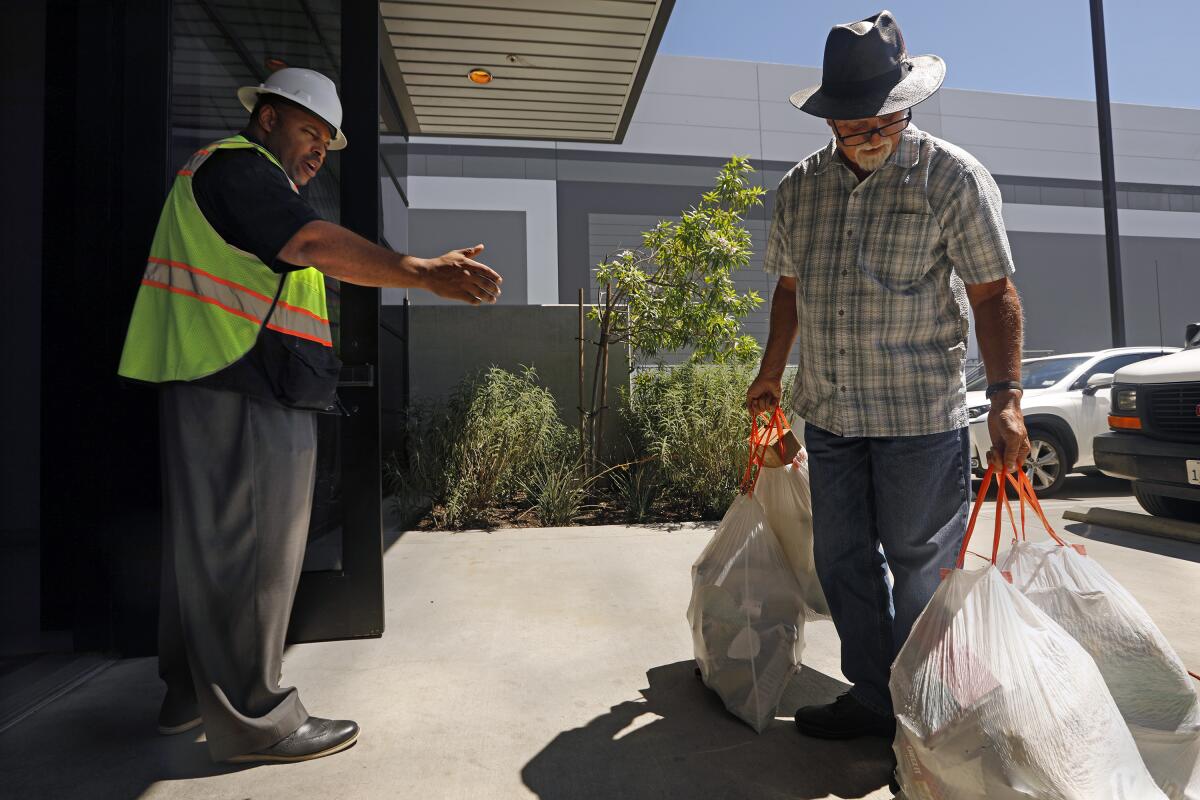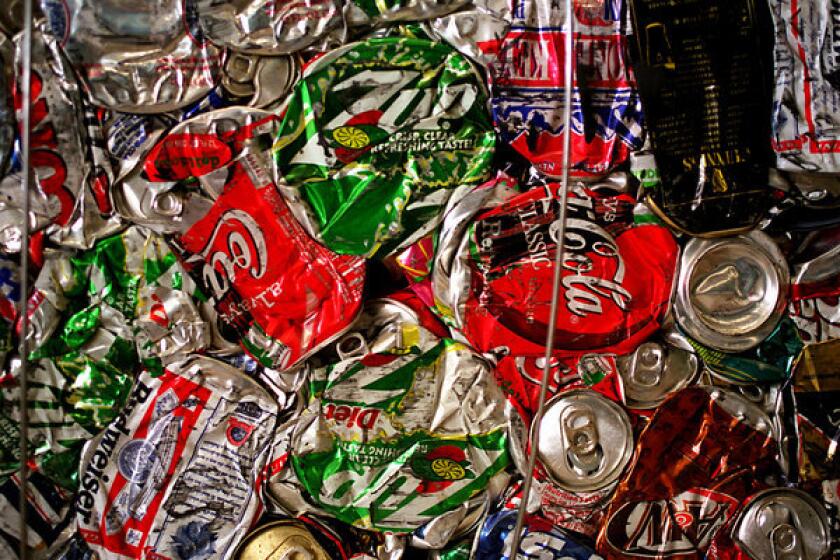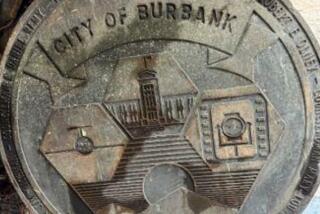Column: I took the contents of my blue bin to the recycling center. Here’s what I learned

Los Angeles Times columnist Steve Lopez brings two weeks of his collected recycling to the Athens Material Recover Facility in Sun Valley to see what exactly is recyclable.
You stopped at a coffee shop, got a cup of Joe to go, then went home and grabbed a yogurt out of the fridge.
Now you’re done, and the question is this:
Do the empty containers go into the trash bin or the blue recycling bin?
Hold on, because I’m going to tell you the answer if you don’t already know it. But first, here’s another question:
You buy a takeout meal that comes in a cardboard container with a plastic lid and plastic utensils. You also get a juice box to go, and your order is placed into a plastic bag.
Do all the empties, and the bag, go into the blue bin?
I have some answers for you, because I saved up all my potential recyclables for two weeks and, instead of parking them curbside, took them directly to the Athens Services Material Recovery Facility in Sun Valley, which receives about one-seventh of the recyclables picked up by the L.A. Sanitation Department.
While I was saving my discards, The Times had two stories about what has become a national recycling crisis. One, by Alex Wigglesworth, was about the collapse of the beverage container recycling market, which is a blow to low-income people who make a few bucks at redemption centers.
The other story, by Piper McDaniel, was about recyclable materials piling up in the United States, due in large part to lower prices and demand from China, which for years was the major purchaser of our waste.
And all this is happening as our consumptive habits require more goods, more packaging, more waste.
The market for our discards is down, but we’re producing more of it than ever, said Enrique Zaldivar, the Sanitation Department’s general manager.
Zaldivar said his department is trying to better educate consumers about what can go in the blue bin and also to develop customers for our recycling waste in Mexico, Canada and the United States, given the dried-up market in Asia.
But there’s something we all need to consider about our own role in the current crisis. Our instant gratification needs lead to more shipping from Amazon and other suppliers, and conservation is not part of the equation. You can order a pair of toenail clippers that lands on your doorstep in two or three boxes big enough to fit a small child inside, along with bubble wrap and maybe some package strapping.
We’ve been lulled into believing that virtually everything we buy at the grocery store and Target and Walmart is recyclable.
— Mark Murray, Californians Against Waste

Mark Murray of Californians Against Waste said plastic packaging is made from natural gas and petroleum products, and because the price of oil is low, it’s cheaper to mass-produce that stuff. If you’ve gone shopping lately, you know that you need a chain saw and possibly some small explosives to extract a pair of garden shears or a set of headphones from all the shrink wrap and flesh-carving molded plastic.
And a lot of that packaging will never be repurposed.
“We’ve been lulled into believing that virtually everything we buy at the grocery store and Target and Walmart is recyclable,” said Murray.
And the truth is that “reducing” (buying a Thermos instead of a thousand water bottles) and “reusing” (taking the same bags to the market again and again) are better for the environment than “recycling.” A lot of “recyclable” waste ends up in landfills either in the U.S. or in China, Indonesia or the Philippines, and some of it isn’t properly disposed of.
“It’s dumped in estuaries and rivers and ultimately ends up floating into bays and oceans as plastic pollution, and a goodly amount of it is ours,” said Murray.
He said two bills pending in Sacramento would help address the recycling crisis. One would require packaging producers to make all plastic materials recyclable. The other would require plastic beverage containers to be made from recycled material — which would help ensure a market for all that recycled plastic. And we can all make a difference by recognizing wasteful packaging and boycotting certain products until the makers and sellers get it right.
For the most part, it’s safe to assume that the most recyclable products are still paper, glass, aluminum and steel, along with higher quality plastics like those found in beverage containers. Even so, there have been many times when I stood in my kitchen with a disposable item and paused over whether to put it into trash or recycling.
When California’s largest operator of recycling centers went out of business last week, the state lost nearly one-fifth of its redemption centers.
Johnny Stevenson, assistant general manager at the Athens plant in Sun Valley, said about 900 tons of blue bin materials arrive at that facility each day. And customers tend to get it right. Stevenson said about 80% of the material is deemed recyclable and 20% gets separated out by automated sorters or by human hand and sent to landfill.
It’s not great that a fifth of what we send to recycling isn’t usable, but it’s not as bad as I expected. And what it says to me is that instead of giving up on recycling, as some have suggested we should, we need to get better at it.
“We’re trying to do everything we can to avoid sending things to landfill,” said Stevenson.
But some customers make that difficult, according to L.A. Sanitation employees Littleton T. Gardner IV and Jose Alonso. In their jobs, they peer into the blue bins at curbside and educate residents on dos and don’ts, and they take their presentation to schools and other locations too.
Gardner said he has found the following items in blue bins:
“Carpet, clothing, shoes, yard waste, dirty diapers, concrete.”
OK, that’s someone who’s not even trying.
Alonso said he, too, has found “a lot of diapers,” along with “garden hoses and soiled hygienic paper that should go in the toilet.”
Disgusting.
I did better than that. Almost everything in my four bags of recycling was acceptable. Newspapers, magazines, cardboard, mail, beer bottles, tomato cans, aluminum cans, wine bottles, empty yogurt cups and the foil lids. As long as there are no fluids in your containers, and materials are clean and dry, you’re pretty safe.
With some exceptions.
The paper cup from a popular coffee chain is not recyclable, in current markets, because of the filmy wax inside. But the cardboard sleeve and plastic lid are recyclable. And so are the plastic cups that cold beverages are served in. What wasn’t recyclable?
One thing that complicates matters is that the market changes from month to month, Stevenson said. At the moment, Athens doesn’t have a buyer for plastic bags, nor for milk and juice cartons with waxy-filmy material and plastic spouts. So Athens is sending those items to landfill at the moment, But the facility says it has lined up customers for both products in the near future.
My dog’s kibble bag will end up in landfill, Stevenson said, because there’s no buyer for the filmy coating on the bag. Plastic utensils go straight to landfill, too. Right now, so does Styrofoam and bubble wrap.
The cardboard bowls from my Blossom restaurant takeout were acceptable, but the plastic lids weren’t. My takeout containers from a favorite haunt — Los Tacos in West Hollywood — were not acceptable because of some bean and cheese residue.
I guess I’m going to have to lick the containers clean next time.
In the name of conservation.
More to Read
Sign up for Essential California
The most important California stories and recommendations in your inbox every morning.
You may occasionally receive promotional content from the Los Angeles Times.












